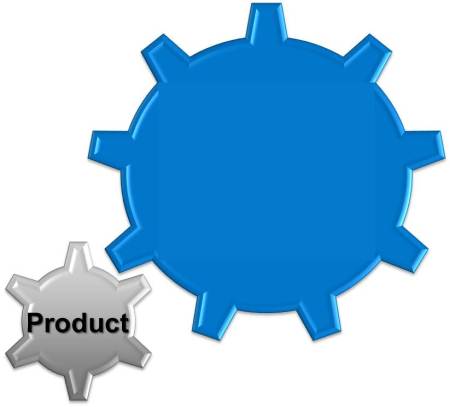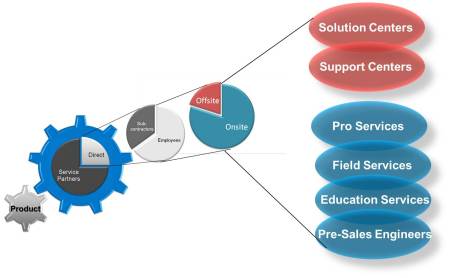In my last post, I mentioned I was heading out to Boston for a one day summit with some TSIA members on the topic of working with service partners. During the summit, we reviewed current and emerging tactics to improve how a product company engages with service partners. One key tactic that discussed is something I dubbed “Managing the Mix.” Here is a summary of the five steps involved with this tactic:
STEP 1: The Total Services Opportunity
When a product is sold, a requirement for services is created. The size of the service requirement is a function of the maturity,
complexity, and nature of the product. In our partner summit, we called this the “big blue gear” of total service requirements. If those service requirements are not satisfied, product sales can slow because customers cannot successfully implement
the product.
Every product company strategize on how this service requirement will be satisfied from a mix of the following resources:
- The customer’s staff
- Service Partners (priming the service engagement)
- Company employees
- Sub-contractors
Currently, it is NOT the common practice for product companies to even attempt to estimate the total services requirement associated
with their products. In part, because product companies leave that task to customers and service partners. However, not estimating the total service requirements surrounding product sales is a missed opportunity for embedded service organizations. By
sizing the entire services requirement, the service organization can change the
conversation:
- Help management understand the importance of investing in partner enablement and internal PS resources to meet the service
requirements. - Help PS, Partner Team, and Sales align on overall sourcing strategy.
- Help partners understand the total services opportunity and the planned capture rate for internal PS.
STEP 2: Direct vs.Indirect
The second step is for the product company to determine how much of the total service requirement it intends to service directly.
Historically, the vast majority of product companies have had very little desire to serve much of these service requirements because the
service margins were dilutive compared to product margins. Product companies are comfortable capturing anywhere from 2% to 20% of the total services opportunity. Beyond that, and there emerge concerns that the product company is becoming a services company.
STEP 3: FTE vs. Sub-contracted
The third step is for the company to review the sub-contracting strategy. For the services the company will be delivering directly (with full time employees), what percentage will be delivered by sub-contracted resources? Over the past five years, TSIA has seen a steady increase in the percentage of direct delivery that is satisfied by leveraging sub-contractors. TSIA benchmark data shoes embedded PS organizations are sub-contracting anywhere from 2% to over 30% of delivery cycles.
STEP 4: Onsite vs. Offsite
The fourth step is to determine what delivery activities can be performed off of the customer site. Once again, TSIA has seen a steady
increase in the percentage of direct delivery that is performed by offsite resources.
STEP 5: Internal Resource Pool
Finally, the services organization should look for synergies across internal resource pools to determine if there are opportunities to
leverage downtime cycles in one group to deliver the services other another group. Historically, there has not been much cycle sharing across internal resource pools due to both process and organizational barriers. Today, service organizations find themselves more motivated to identify these cost saving opportunities.
Why All Five Steps?
Why are all five steps important in improving the engagement with service delivery partners? Because the more a product company truly understands its strategy to meet the total service needs of customers, the better decisions the company can make when setting its partner strategy. Not understanding at least “the big blue gear” can lead to some dysfunctional decisions regarding overall service strategy as well as partner strategy.
If you are a TSIA member and you would like the complete summary report from the Partner Member Summit, please contact me directly at thomas@tsia.com.





February 12, 2012 at 3:09 pm |
[…] Managing the Mix: Changing the Partner Management Dialogue […]